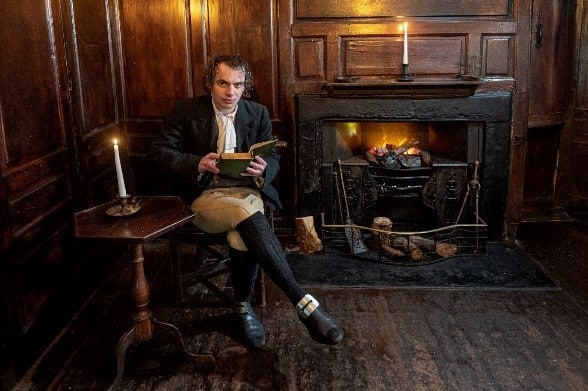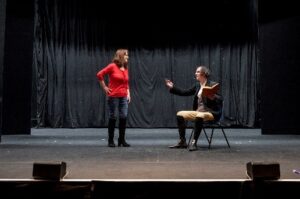
Scotland’s National Poet braved the winter storms to revisit some of his favourite Dumfries haunts before Burns Night this Thursday.
His visit marks the start of a new joint campaign to establish Dumfries as The Bard’s Town. The Burns Tourism Partnership aims to celebrate Dumfriesshire’s unparalleled connections to Robert Burns, as the region where the poet lived, composed and performed during some of the most prolific years of his life.
Joan McAlpine, Business Development Manager at Robert Burns Ellisland Farm & Museum, where Burns lived with his family in the late 18th century, is a key member of the drive to put Dumfries and Nithsdale on the map as a must-visit Burns destination.

Burns reciting to Joan McAlpine of the Robert Burns Ellisland Farm & Museum in the Theatre Royal, Dumfries
She accompanied Burns on his jaunt around his old stomping ground and said:
“It was an honour to join Burns as he revisited many of the places he spent time in during the later years of his life. From his favourite howff The Globe Inn, where to this day punters can enjoy a dram in the very corner where Burns once caroused and recited, to the Theatre Royal and his red sandstone former home – now the Robert Burns House museum – his legacy lives on in this part of the world and we are so looking forward to inspiring legions more visitors to discover why Dumfries is truly the Bard’s town.”
The Burns Tourism Partnership comprises the following partner organisations: the SSDA, Robert Burns Ellisland Museum and Farm, Dumfries and Galloway Council, Theatre Royal Dumfries, The Globe Inn, Big Burns Supper, The Stove, DG Unlimited, Wigtown Book Festival, Annandale Distillery, Galloway Cycling Holidays, University of Glasgow, A @ the Airts, VisitScotland and SOSE, as well as others.
Burns locations in Dumfries & Galloway include:
- The Theatre Royal – Burns was heavily involved in the construction of Scotland’s oldest working theatre and wrote several pieces for performance on the stage, including The Rights of Women for Louise Fontanelle to perform in 1792 following the opening of the new Theatre.
- The Globe Inn – Burns regularly frequented The Globe Inn from when he moved to Dumfriesshire in 1788 until the end of his life. Visitors can sit in the chair Burns sat in, read verses Burns etched onto the windowpanes, and visit the room where he stayed in the Inn.
- Robert Burns House – Burns lived in the centre of Dumfries for the final three years of his life until his death in 1796. The house is full of artefacts including several original manuscripts and is a site of pilgrimage for Burns enthusiasts from across the world.
- Robert Burns Statue – Unveiled in 1882 and restored in 2005, this statue of Robert Burns was commissioned by Dumfries town council in 1877. Carved in Carrara marble, it was sculpted by Amelia Paton Hill and includes a dog at his feet.
- Robert Burns Ellisland Farm & Museum – Burns and his family lived at the farm near Auldgirth on the outskirts of Dumfries – in a house he commissioned and had built – from 1788-1791. These were his most creative and fruitful years for poetry and song (both Tam o’Shanter and Auld Lang Syne were composed at Ellisland). Ellisland Farm is now part of global game sensation Minecraft, allowing people from all over the world to discover Burns’ home.
- Robert Burns Centre – Situated in an 18th-century watermill by the banks of the River Nith, the centre tells the story of Burns in Dumfries, with an impressive scale model of the town in the 1790s. The Centre becomes a film theatre in the evening, showcasing the best in contemporary cinema.
- Burns Mausoleum – Burns was originally buried in the north-east corner of St Michael’s Churchyard, however a public subscription campaign spearheaded by Sir Walter Scott raised enough funds from devoted Burns fans from all over the world to finance the Mausoleum. It was built by local stonemason John Milligan with a tender for £331.8s.6d. The first stone was laid in 1815.


